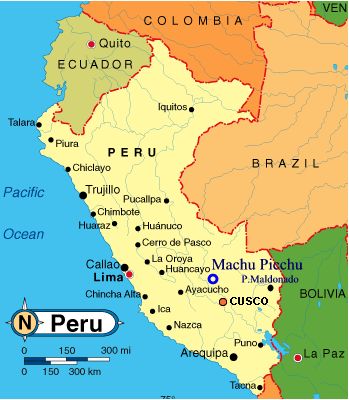
The coat of arms of Peru contains the escutcheon or shield, consisting of three elements: the top left section shows the
vicuña, the national animal, on a light-blue field, representing the fauna of Peru; the tree in the top right section is the
cinchona tree (the source of quinine, a powerful anti-malarial drug and the key flavorant in "tonic water," used in making gin-and-tonics), on a white background, representing the national flora; and the bottom cornucopia with coins spilling from it, on a red field, represents the mineral resources of the country.

Machu Picchu was constructed around 1450, at the height of the Inca empire, and was abandoned less than 100 years later, as the empire collapsed under Spanish conquest. Although the citadel is located only about 50 miles from Cusco, the Inca capital, it was never found and destroyed by the Spanish, as were many other Inca sites. Over the centuries, the surrounding jungle grew to enshroud the site, and few knew of its existence. It was "discovered" in 1911 by Yale historian and explorer Hiram Bingham.

A map of Peru.
 The coat of arms of Peru contains the escutcheon or shield, consisting of three elements: the top left section shows the vicuña, the national animal, on a light-blue field, representing the fauna of Peru; the tree in the top right section is the cinchona tree (the source of quinine, a powerful anti-malarial drug and the key flavorant in "tonic water," used in making gin-and-tonics), on a white background, representing the national flora; and the bottom cornucopia with coins spilling from it, on a red field, represents the mineral resources of the country.
The coat of arms of Peru contains the escutcheon or shield, consisting of three elements: the top left section shows the vicuña, the national animal, on a light-blue field, representing the fauna of Peru; the tree in the top right section is the cinchona tree (the source of quinine, a powerful anti-malarial drug and the key flavorant in "tonic water," used in making gin-and-tonics), on a white background, representing the national flora; and the bottom cornucopia with coins spilling from it, on a red field, represents the mineral resources of the country. Machu Picchu was constructed around 1450, at the height of the Inca empire, and was abandoned less than 100 years later, as the empire collapsed under Spanish conquest. Although the citadel is located only about 50 miles from Cusco, the Inca capital, it was never found and destroyed by the Spanish, as were many other Inca sites. Over the centuries, the surrounding jungle grew to enshroud the site, and few knew of its existence. It was "discovered" in 1911 by Yale historian and explorer Hiram Bingham.
Machu Picchu was constructed around 1450, at the height of the Inca empire, and was abandoned less than 100 years later, as the empire collapsed under Spanish conquest. Although the citadel is located only about 50 miles from Cusco, the Inca capital, it was never found and destroyed by the Spanish, as were many other Inca sites. Over the centuries, the surrounding jungle grew to enshroud the site, and few knew of its existence. It was "discovered" in 1911 by Yale historian and explorer Hiram Bingham.  A map of Peru.
A map of Peru.


No comments:
Post a Comment